Chapter 1: Financial Management Setup
CHAPTER 1: FINANCIAL MANAGEMENT SETUP
Objectives
The objectives are:
• Explain the fields on the General Ledger Setup window.
• Explain and set up Accounting Periods.
• Explain and set up Trail Codes, including Source Codes and Reason
Codes.
Prior to processing financials in Microsoft Dynamics™ NAV 5.0, the following
areas in Financial Management must be set up:
Introduction
• General Ledger
• Accounting Periods
• Trail Codes, including:
– Source Codes
– Reason Codes
In this section, these set up areas are explained.
NOTE: There are other setup areas in the General Ledger, such as Currencies,
No. Series, Dimensions, and Posting Groups. The set up of these areas is
discussed in the sections specific to these topics in the Application Setup
content.
1-1
Microsoft Official Training Materials for Microsoft Dynamics ™ Your use of this content is subject to your current services agreement �
Finance in Microsoft Dynamics™ NAV 5.0
General Ledger Setup
The General Ledger Setup window is used to specify default setting for the
general ledger and all finance related application areas. The General Ledger
Setup window must be completed for each company set up in Microsoft
Dynamics NAV 5.0.
This section describes the five tabs and fields on the General Ledger Setup
window. For more information on these fields, press F1 to access online help.
To access the General Ledger Setup window, on the Navigation Pane, click
Financial Management > Setup > General Ledger Setup.
FIGURE 1.1 GENERAL LEDGER SETUP WINDOW
General Tab
The General tab contains the basic setup defaults for General Ledger, including:
Field
Allow Posting From / Allow
Posting To
Definition
Specify the company default posting dates;
that is, the date range that all users can post
transactions in.
Since a period closing process is not required
in Microsoft Dynamics NAV 5.0, setting the
posting date range prevents users from posting
entries that can change prior period data.
NOTE: Specific user posting date restrictions
are specified in the User Setup window. If
there are no user restrictions, the company
defaults are in effect. If there are no company
defaults, there are no restrictions on dates for
data entry and posting.
1-2
Microsoft Official Training Materials for Microsoft Dynamics ™ Your use of this content is subject to your current services agreement �
Chapter 1: Financial Management Setup
Field
Register Time
Local Address Format
Local Cont. Addr. Format
Invoice Rounding Precision
(LCY)
Invoice Rounding Type
(LCY)
Allow G/L Acc. Deletion
Before
Check G/L Account Usage
EMU Currency
LCY Code
Pmt. Disc. Excl. VAT
Adjust for Payment Disc.
Unrealized VAT
Max. VAT Difference
Allowed
Definition
Specify whether the program registers the
user's time usage.
Specify the address format used on printed
documents.
Specify where the contact name needs to
appear in mailing addresses.
Specify the size of the interval to be used
when rounding amounts in local currency
(LCY).
Specify if invoice amounts are rounded up or
down. The option selected here is used with
the rounding interval specified in the Invoice
Rounding Precision (LCY) field.
The date in this field determines if and when
G/L accounts can be deleted. G/L accounts
with entries on or after the date specified in
this field cannot be deleted.
If selected, the program prevents G/L accounts
that are used in setup tables, such as posting
groups, from being deleted.
Select this field if LCY is an EMU currency.
This field is only used when applying entries
in different currencies.
Enter the currency code for LCY. The value is
only used on printouts, since the program uses
as the indicator for LCY when
displaying information in tables.
Specify whether the payment discount is based
on amounts including or excluding VAT.
If selected, the program recalculates VAT
amounts when posting payments that trigger
payment discounts.
Specify whether the program manages
unrealized VAT. For more information, refer
to “VAT and Intrastat.”
Enter the maximum VAT correction amount
allowed for the local currency.
1-3
Microsoft Official Training Materials for Microsoft Dynamics ™ Your use of this content is subject to your current services agreement �
Finance in Microsoft Dynamics™ NAV 5.0
Field
VAT Rounding Type
Bill-to/Sell-to VAT Calc.
Print VAT Specification in
LCY
Numbering Tab
Definition
Select how VAT is rounded when calculated
for the local currency.
By default this field is set to Bill-to/Pay-to
No., which indicates that the VAT Business
Posting Group is taken from the Bill-to
customer or Pay-to vendor for orders/invoices.
Select Sell-to/Buy-from No. to use the VAT
Business Posting Group for the Sell-to
customer or Buy-from vendor for
orders/invoices.
If selected, a line is added on printed sales
documents that specifies the VAT details in
LCY in addition to the invoicing currency. If
not selected, VAT details will only print in the
invoicing currency.
Bank Account Nos. is the only field on the Numbering tab. In this field, enter
the code for the number series that will be used to assign numbers to bank
accounts.
No. Series are described and set up in the Application Setup content.
Dimensions Tab
On the Dimensions tab, specify the global and shortcut dimensions to be used for
financial reporting. The codes specified here are selected from the dimensions set
up in the Dimension table, as described in the Dimensions section in the
Application Setup content.
FIGURE 1.2 GENERAL LEDGER SETUP WINDOW, DIMENSIONS TAB
1-4
Microsoft Official Training Materials for Microsoft Dynamics ™ Your use of this content is subject to your current services agreement �
Chapter 1: Financial Management Setup
Global dimensions can be used:
• As filters for G/L entries.
• On all reports, account schedules, and batch jobs.
Determine which two dimensions are likely to be analyzed most frequently and
select these as the two global dimensions.
Shortcut dimensions offer a fast and convenient way to enter dimension
information directly on the line in journals and in sales and purchase documents.
The program automatically creates the first two shortcut dimensions using the
Global Dimensions. The other six shortcut dimensions are available only if
Advanced Dimensions are purchased.
Functions Button
The Functions button on the General Ledger Setup window contains two
functions:
• Change Global Dimensions
• Change Payment Tolerance
Use the Change Global Dimensions batch job to change either one or both of
the global dimensions.
NOTE: Changing a global dimension code requires that the program make
changes to entries already posted. It is important to carefully consider which
dimension codes are designated as global dimension to minimize the need for
future changes.
Use the Change Payment Tolerance batch job to:
• Change either the maximum payment tolerance or the payment
tolerance percentage.
• Filter by currency.
Reporting Tab
The Reporting tab is used to determine if and how additional reporting currency
is used. Additional reporting currency is used when transaction information also
needs to be available in a currency other than local currency.
1-5
Microsoft Official Training Materials for Microsoft Dynamics ™ Your use of this content is subject to your current services agreement �
Finance in Microsoft Dynamics™ NAV 5.0
The fields on the Reporting tab are:
Field
Additional Reporting Currency
Definition
Specify the currency used as an
additional reporting currency in the
General Ledger area. If specified:
• G/L and other entries, including
VAT entries in both LCY, and
additional reporting currency are
automatically recorded.
the additional reporting currency.
VAT Exchange Rate Adjustment Used with the Additional Reporting
• Reports are printed in either LCY or
Currency field, to specify how the
accounts set up for VAT posting in the
VAT Posting Setup table are adjusted for
exchange rate fluctuations between LCY
and the additional reporting currency.
Application Tab
The fields on the Application tab are used to specify:
• Currency rounding tolerance
• How payments are applied to outstanding amounts, including:
– Payments from customers
– Payments to vendors
The Application tab contains the following fields:
Field
Appln. Rounding Precision
Payment Disc. Tolerance Warning,
Payment Disc. Tolerance Posting,
and Payment Discount Grace Period
Definition
Specify the size of the interval allowed
as a rounding difference for LCY
when applying LCY entries to entries
in a different currency.
Complete these fields to allow
tolerance on payment discount terms.
More information concerning payment
discount tolerance is available in the
Receivables Management and
Payables Management sections of the
Finance content.
1-6
Microsoft Official Training Materials for Microsoft Dynamics ™ Your use of this content is subject to your current services agreement �
Chapter 1: Financial Management Setup
Field
Payment Tolerance Warning and
Payment Tolerance Posting
Definition
Complete these fields to close
outstanding receivables and payables
with payment amounts that are
different from what is owed. More
information concerning payment
tolerance is available in the
Receivables Management and
Payables Management sections of the
Finance content.
Matching Activity: General Ledger Setup Window
Task: The following are characteristics of the General Ledger Setup window.
Match the characteristic to the elements on General Ledger Setup window.
_____ 1. Contains only one field.
_____ 2. Prevent entries that can change
prior period data.
_____ 3. Used to specify two globals and
up to eight shortcuts.
_____ 4. A function can be run from this
window to change this.
_____ 5. LCY is the acronym for this.
_____ 6. Determine if and how additional
reporting currency is used.
a. Allow Posting From /
Allow Posting To fields
b. Local Currency
c. Dimensions tab
d. Reporting tab
e. Numbering tab
f. Payment Tolerance
Accounting Periods
Before posting in a fiscal year in Microsoft Dynamics NAV 5.0:
• The fiscal year must be opened.
• Accounting periods must be defined.
The shortest possible accounting period is one day and at least one accounting
period must be set up for each fiscal year.
The Accounting Periods window is used to:
• Open new fiscal years
• Define accounting periods
• Close fiscal years
1-7
Microsoft Official Training Materials for Microsoft Dynamics ™ Your use of this content is subject to your current services agreement �
Finance in Microsoft Dynamics™ NAV 5.0
Accounting periods can be used as a time reference in Microsoft Dynamics NAV
5.0. For example, when reviewing posted entries in a Balance/Budget window,
the length of the accounting period, such as one month or one quarter, is
specified.
In this section, Accounting Periods are set up.
Set up an Accounting Period Manually
Accounting Periods can be created using one of the following methods:
• Manually
• Automatically using the Create Fiscal Year batch job.
To manually set up an Accounting Period, follow these steps:
1. On the Navigation Pane, click Financial Management > Setup >
Accounting Periods.
FIGURE 1.3 ACCOUNTING PERIODS WINDOW
2. In the Starting Date field, enter the date that the accounting period
begins.
3. In the Name field, the name of the month corresponding to the
Starting Date is entered as a default. Update this field as necessary.
4. Place a check mark in the New Fiscal Year check box to indicate the
start of the year.
5. Repeat steps 1-2 for each month in the period.
The New Fiscal Year check box must contain a check mark if an accounting
period is the first one in a fiscal year. Microsoft Dynamics NAV 5.0 uses that
period to determine which periods to close when the Close Year function is run.
1-8
Microsoft Official Training Materials for Microsoft Dynamics ™ Your use of this content is subject to your current services agreement �
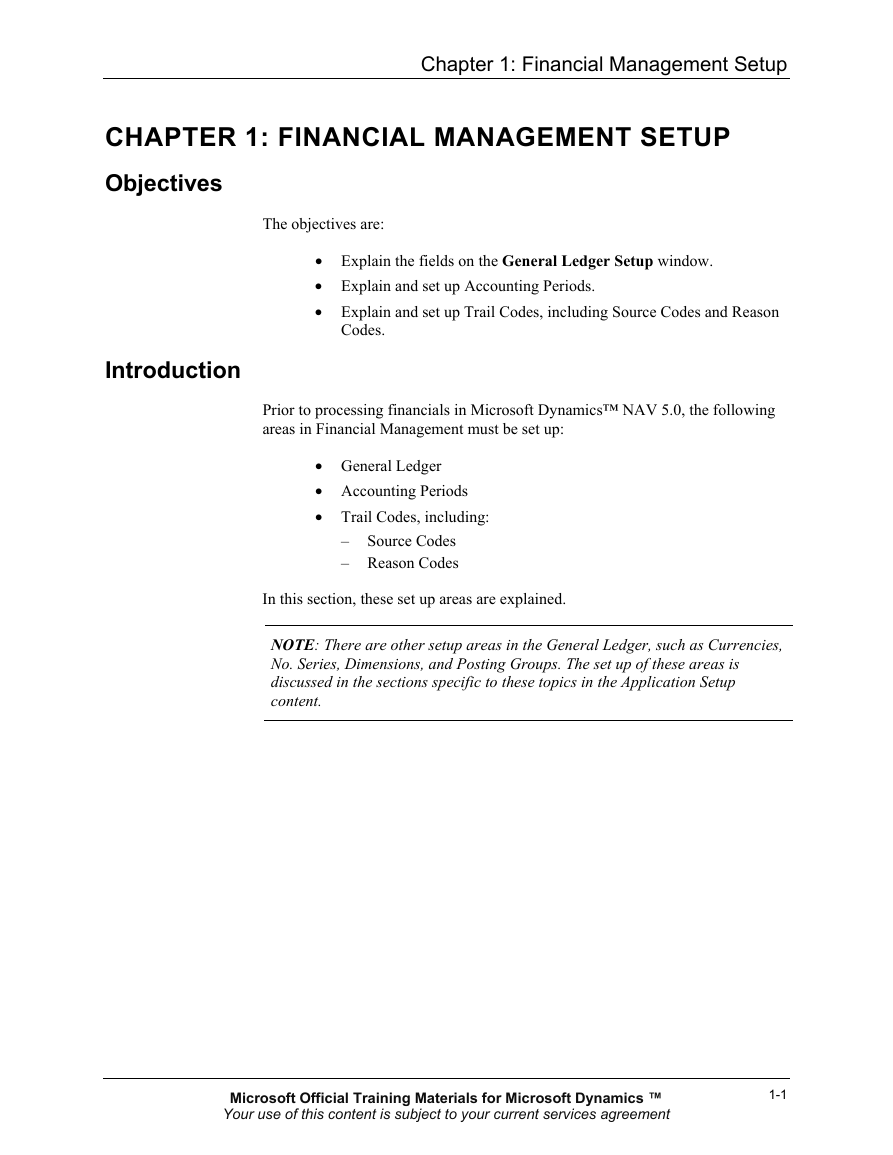
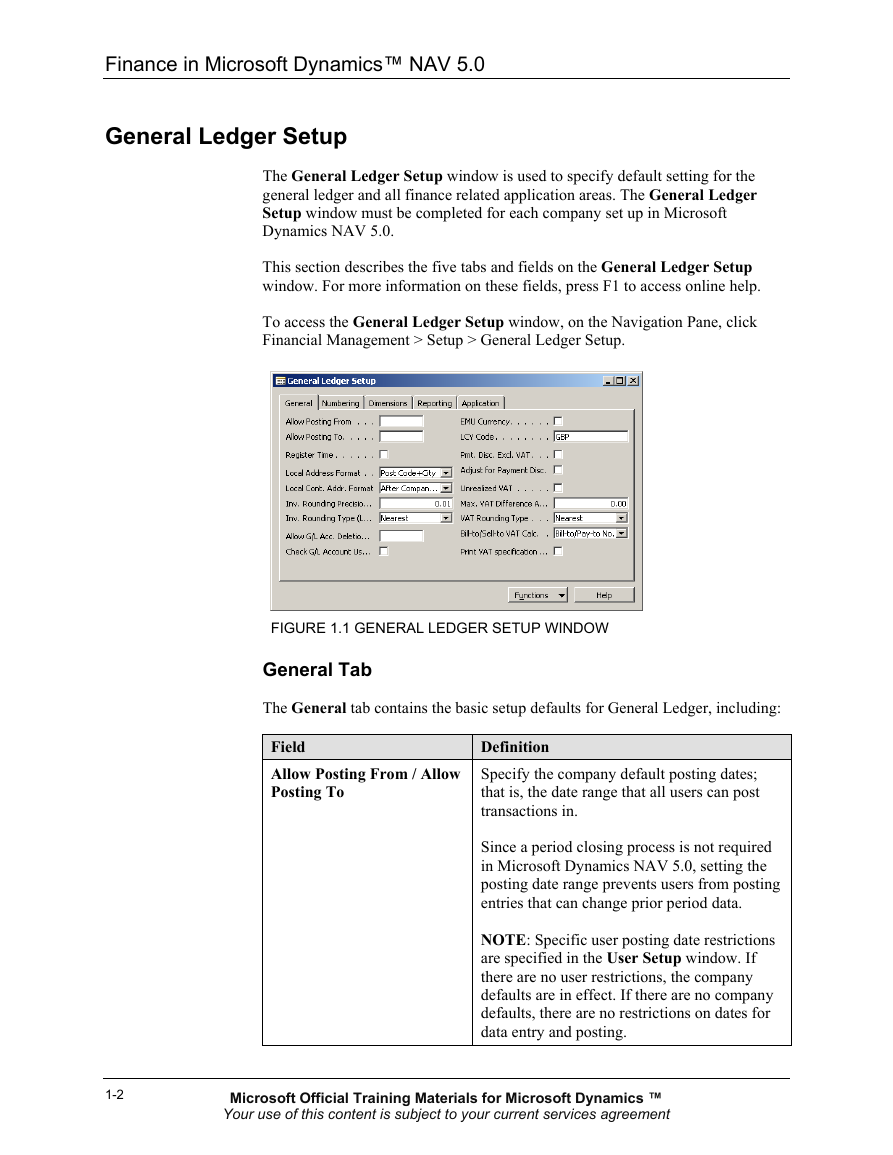
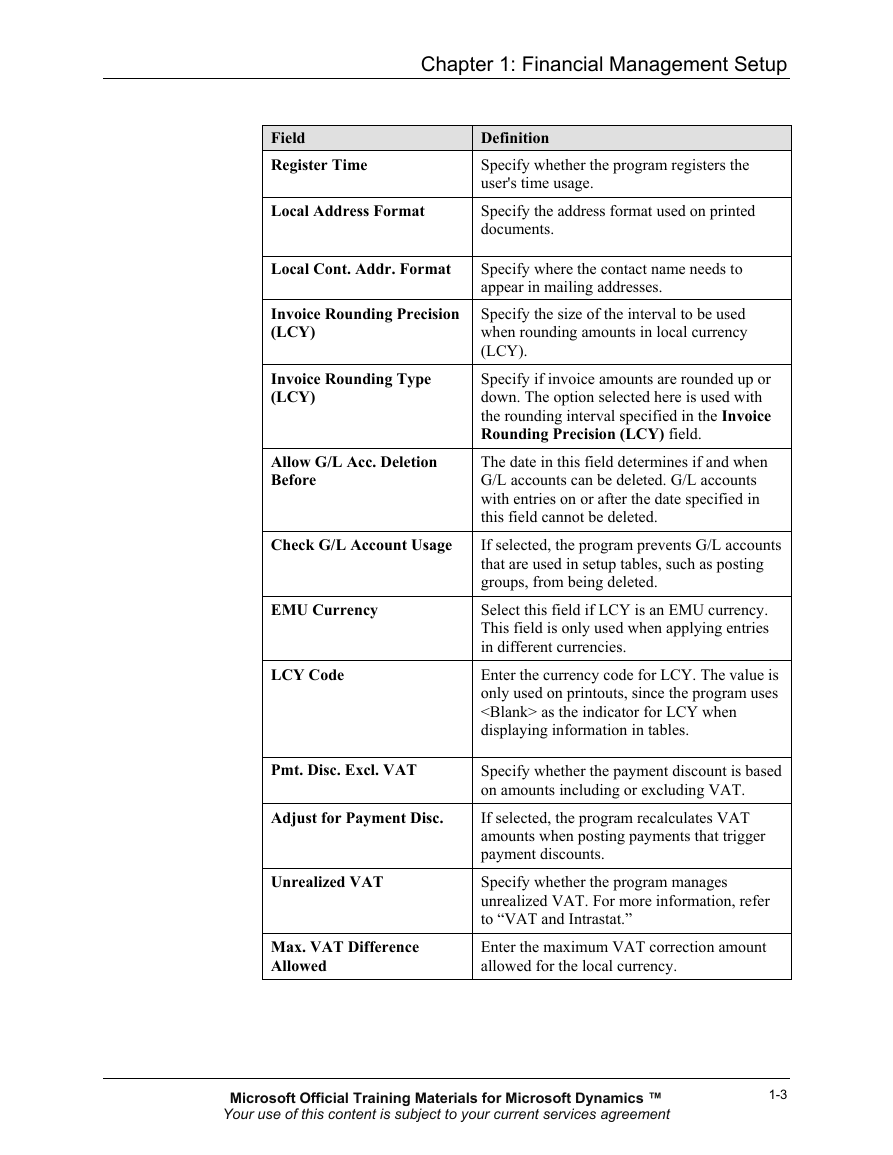

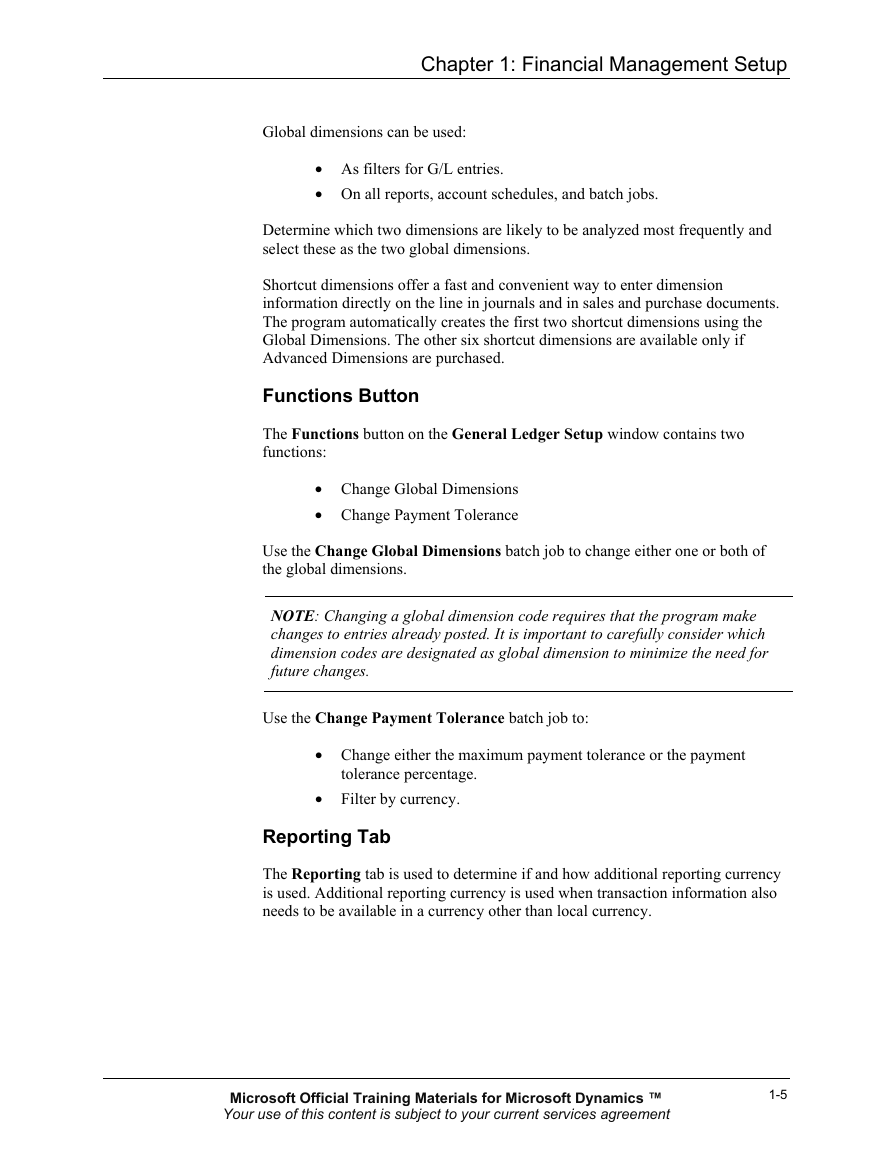

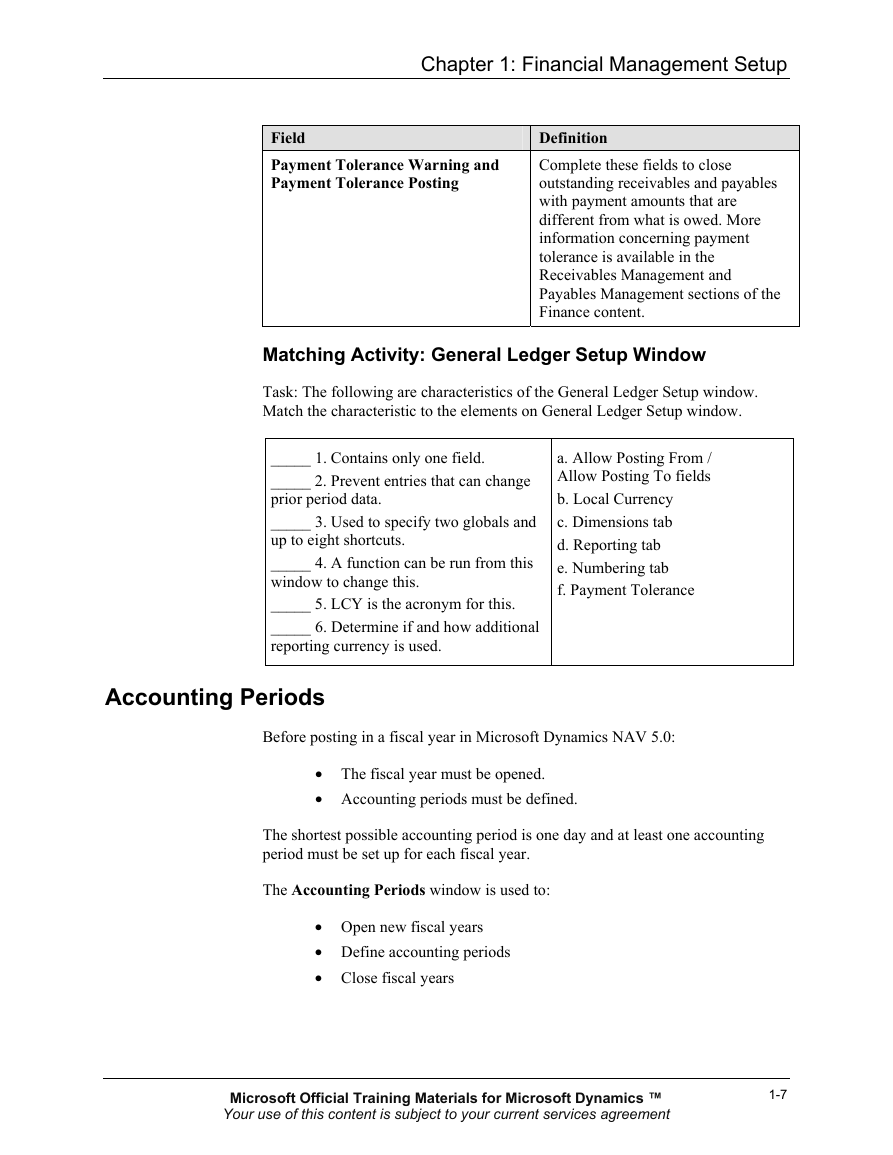
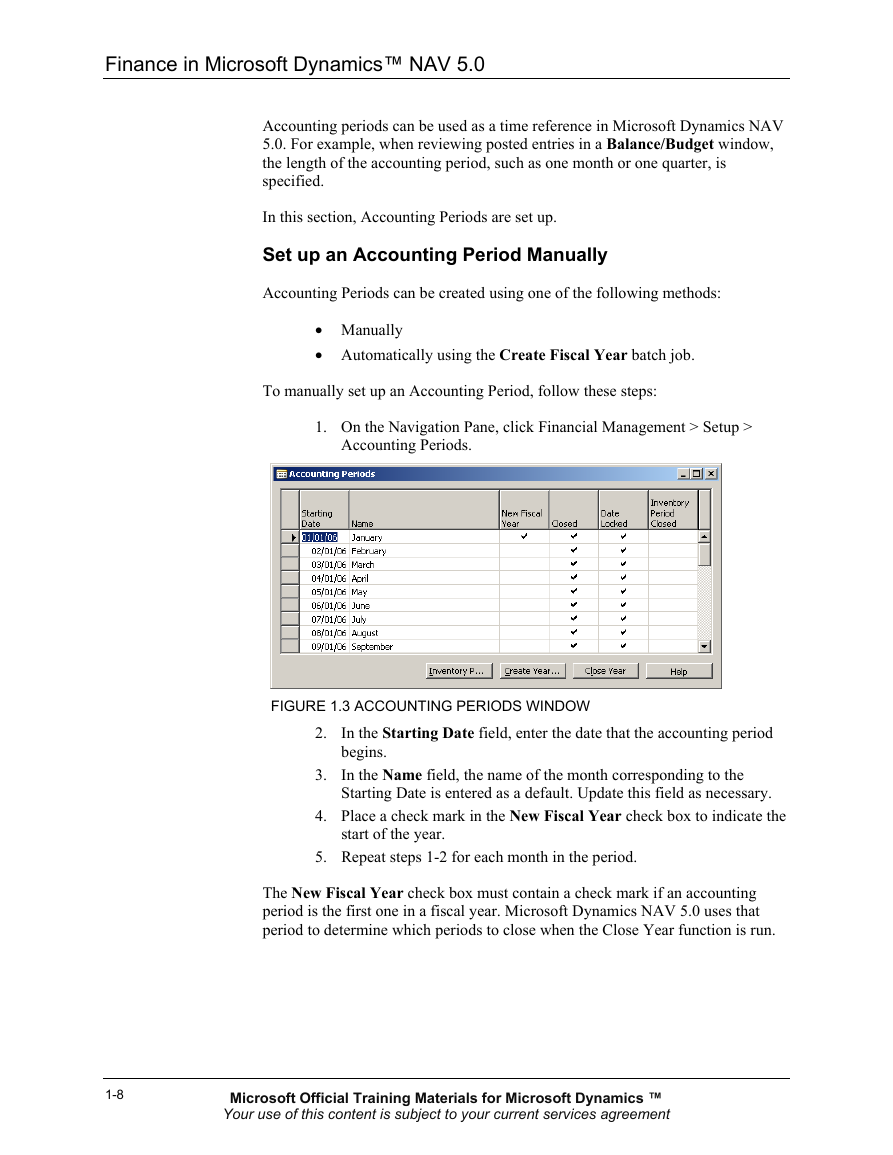








 2023年江西萍乡中考道德与法治真题及答案.doc
2023年江西萍乡中考道德与法治真题及答案.doc 2012年重庆南川中考生物真题及答案.doc
2012年重庆南川中考生物真题及答案.doc 2013年江西师范大学地理学综合及文艺理论基础考研真题.doc
2013年江西师范大学地理学综合及文艺理论基础考研真题.doc 2020年四川甘孜小升初语文真题及答案I卷.doc
2020年四川甘孜小升初语文真题及答案I卷.doc 2020年注册岩土工程师专业基础考试真题及答案.doc
2020年注册岩土工程师专业基础考试真题及答案.doc 2023-2024学年福建省厦门市九年级上学期数学月考试题及答案.doc
2023-2024学年福建省厦门市九年级上学期数学月考试题及答案.doc 2021-2022学年辽宁省沈阳市大东区九年级上学期语文期末试题及答案.doc
2021-2022学年辽宁省沈阳市大东区九年级上学期语文期末试题及答案.doc 2022-2023学年北京东城区初三第一学期物理期末试卷及答案.doc
2022-2023学年北京东城区初三第一学期物理期末试卷及答案.doc 2018上半年江西教师资格初中地理学科知识与教学能力真题及答案.doc
2018上半年江西教师资格初中地理学科知识与教学能力真题及答案.doc 2012年河北国家公务员申论考试真题及答案-省级.doc
2012年河北国家公务员申论考试真题及答案-省级.doc 2020-2021学年江苏省扬州市江都区邵樊片九年级上学期数学第一次质量检测试题及答案.doc
2020-2021学年江苏省扬州市江都区邵樊片九年级上学期数学第一次质量检测试题及答案.doc 2022下半年黑龙江教师资格证中学综合素质真题及答案.doc
2022下半年黑龙江教师资格证中学综合素质真题及答案.doc